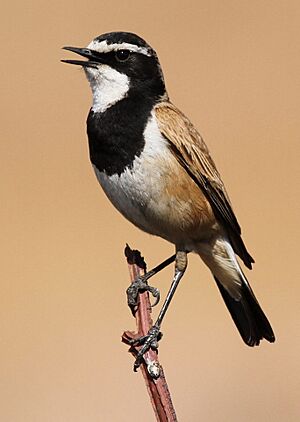Capped wheatear facts for kids
Quick facts for kids Capped wheatear |
|
|---|---|
 |
|
| Conservation status | |
| Scientific classification |
The capped wheatear (Oenanthe pileata) is a small bird that loves to eat insects. You can find it all over southern Africa. It used to be grouped with the thrush family, but now scientists place it with the Old World flycatcher family, called Muscicapidae.
Contents
About the Capped Wheatear's Name
Scientists give every animal a special two-part name, like Oenanthe pileata for the capped wheatear. This helps everyone around the world know exactly which animal they are talking about.
The capped wheatear was first officially described in 1789 by a German scientist named Johann Friedrich Gmelin. He put it in the same group as wagtails and gave it the name Motacilla pileata. The word pileata comes from Latin and means "capped," which makes sense because of the bird's black cap!
Another English bird expert, John Latham, had described this bird earlier in 1783. He called it the "Black-hooded wheat-ear." Latham's bird was found near the Cape of Good Hope in South Africa.
Today, the capped wheatear is part of a different group of birds called Oenanthe. This group was created by a French scientist named Louis Pierre Vieillot in 1816.
There are three main types, or subspecies, of capped wheatears:
- O. p. neseri – found in places like southern Angola, Namibia, western Botswana, and northwest South Africa.
- O. p. livingstonii – lives from central Kenya down to northeast South Africa and eastern Botswana.
- O. p. pileata – found in southwest Namibia and most of South Africa.
What Does a Capped Wheatear Look Like?
The capped wheatear is about 17–18 cm long, which is roughly the length of a pen. It weighs about 32 grams, which is like carrying a few small candies. Its legs and pointy beak are black.
This bird is easy to spot because of its unique look! Adult capped wheatears have a black cap on their head, black cheeks, and a black band across their chest. They also have a white stripe above their eye and a white throat. The rest of their belly is white, with a bit of buff (a pale yellowish-brown color) on their sides.
Like other wheatears, this bird has a special tail pattern. The feathers at the base and center of its tail are black, forming an upside-down "T" shape against the otherwise white lower back.
Young capped wheatears look a bit different. They have a brown cap and cheeks, and their chest band is not as clear. However, you can still tell them apart from other similar birds, like the northern wheatear, by their chest band, slightly larger size, and the white feathers at the base of their outer tail.
Where Capped Wheatears Live
You can find the capped wheatear in open, dry areas across Africa. They like sandy or stony places and short grasslands that have a few bushes and termite mounds. Their home range stretches from Kenya and Angola all the way south to the Cape of Good Hope.
These birds usually stay in one area and don't travel far. However, they might move a little bit during different seasons to find food or better conditions.
How Capped Wheatears Behave
The capped wheatear has a loud, pretty song that sounds like a mix of melodies and chattering. When they are alarmed, they make a "chik-chik" sound.
These birds usually have one partner for life. They build their nests in holes in the ground or inside termite mounds, using straw, grass, and leaves. Sometimes, they even use man-made drainage pipes if they can find them! A female typically lays three or four eggs, but sometimes more.
Capped wheatears are often seen alone. They love to eat insects, especially ants. Just like other wheatears, they like to perch on top of small mounds and then hop around in the short grass, or fly low over the ground, looking for their next meal.


